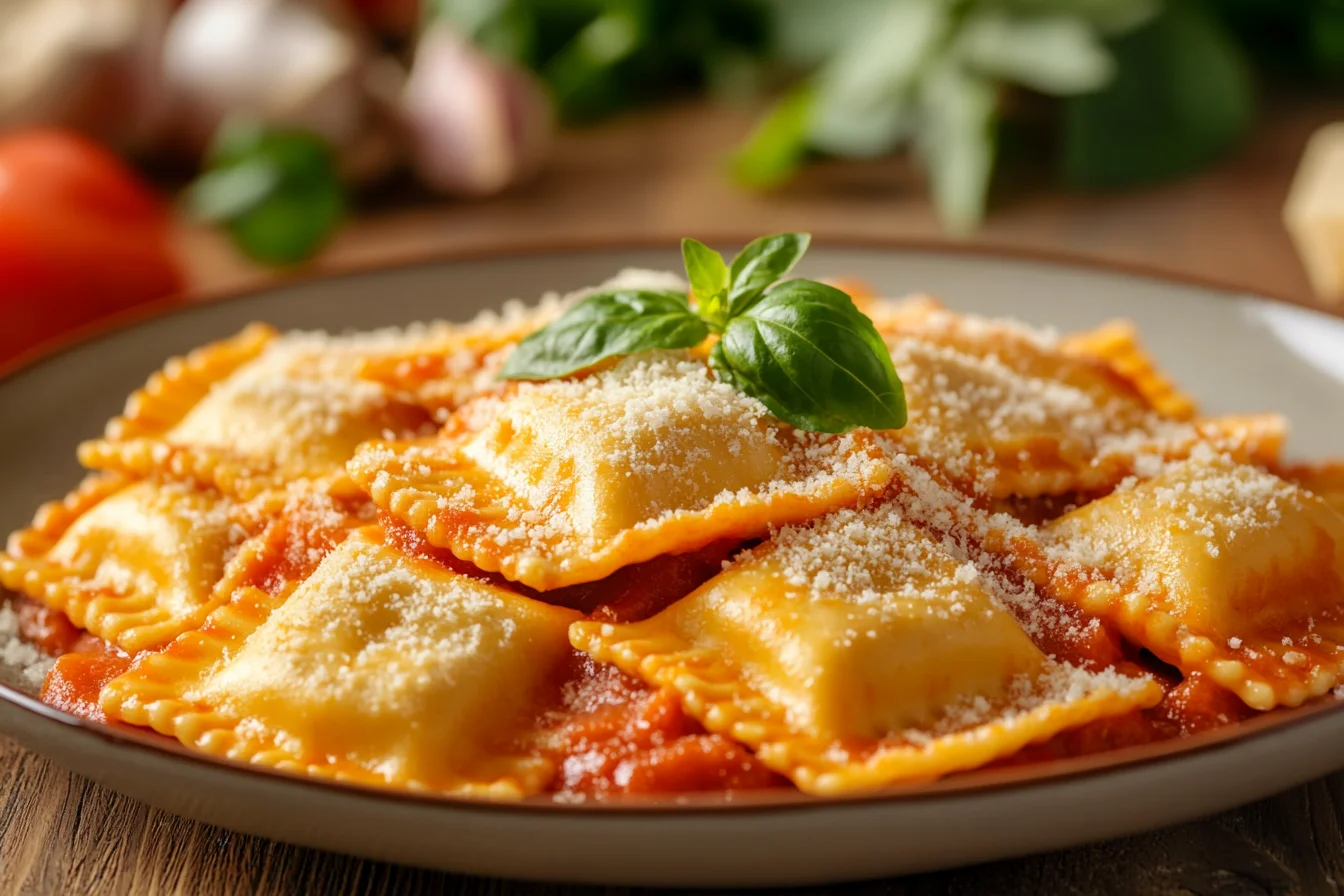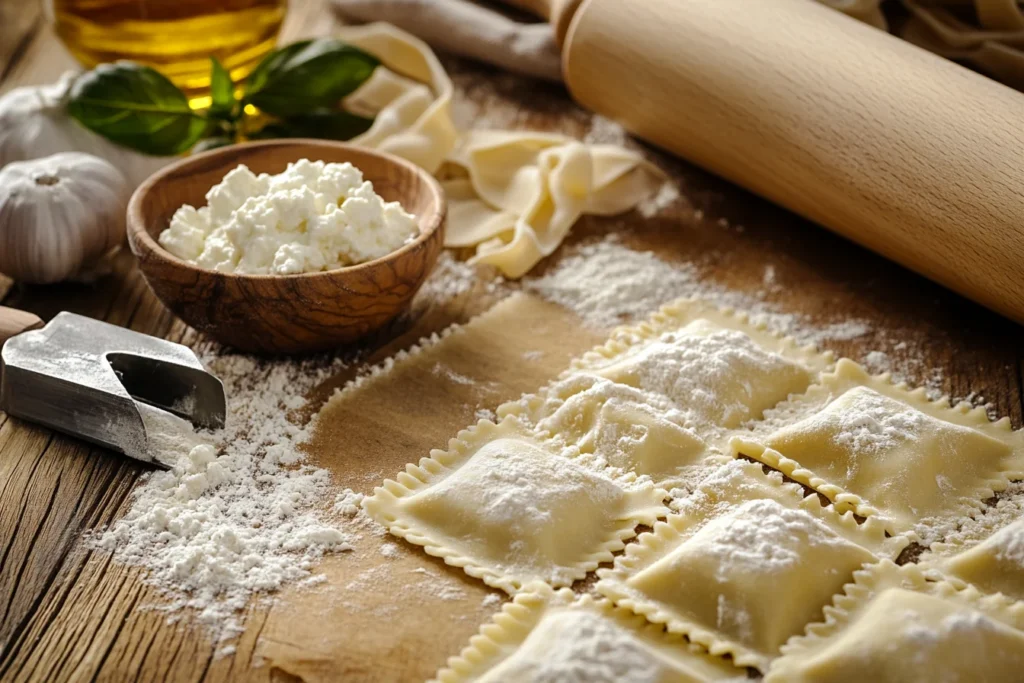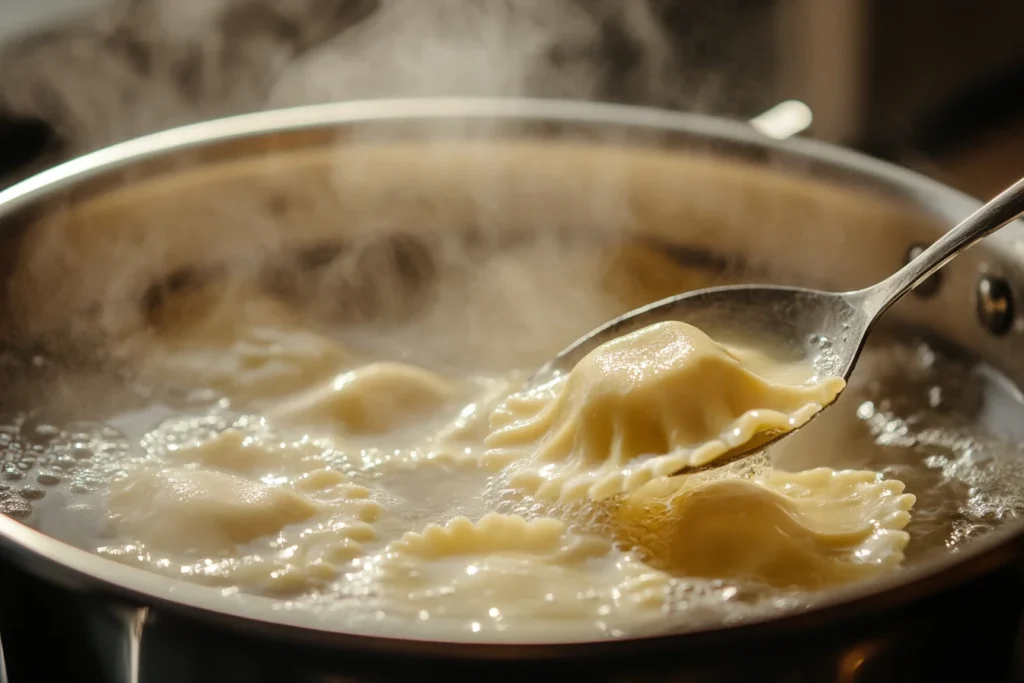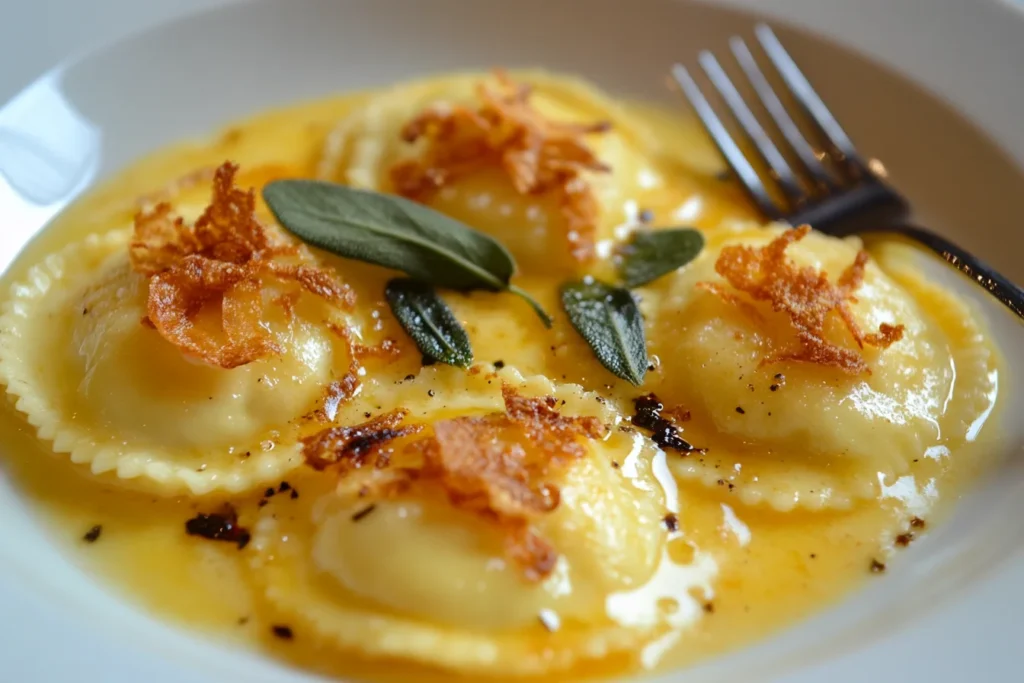Cheese ravioli is a classic Italian dish featuring pasta pockets filled with creamy ricotta, parmesan, and herbs. Whether paired with marinara, butter and sage, or Alfredo sauce, it offers endless versatility.
Originating in Italy, ravioli has become a global favorite, enjoyed both homemade and in restaurants. Fresh ravioli enhances flavor and texture, while store bought options add convenience. This article explores its history, ingredients, preparation, and serving ideas, showcasing why cheese ravioli remains a timeless delight.
Table of Contents

Cheese Ravioli
Ingredients
For the Pasta Dough:
- 2 cups all purpose flour plus extra for dusting
- 2 large eggs
- ½ teaspoon salt
- 1 tablespoon olive oil
- 2 –3 tablespoons water as needed
For the Cheese Filling:
- 1 cup ricotta cheese
- ½ cup grated parmesan cheese
- ½ cup shredded mozzarella cheese
- 1 egg yolk
- ½ teaspoon salt
- ¼ teaspoon black pepper
- ¼ teaspoon nutmeg optional
- 1 tablespoon chopped fresh basil or parsley
For Cooking and Serving:
- 1 tablespoon salt for boiling water
- 2 cups marinara sauce or preferred sauce
- Grated parmesan and fresh basil for garnish
Instructions
1. Prepare the Pasta Dough:
- On a clean surface, form a mound with the flour and create a well in the center.
- Crack the eggs into the well, add salt and olive oil, then gradually mix with a fork.
- Knead for about 10 minutes until smooth and elastic. Wrap in plastic and let rest for 30 minutes.
2. Make the Cheese Filling:
- In a bowl, mix ricotta, parmesan, mozzarella, egg yolk, salt, pepper, nutmeg, and herbs until well combined.
3. Roll Out the Pasta Dough:
- Divide the dough into two equal parts and roll each into thin sheets (about 1/16 inch thick).
- Place small spoonfuls of filling evenly spaced on one sheet.
- Lay the second sheet over the first, pressing around each filling mound to seal.
4. Cut and Seal the Ravioli:
- Use a knife or ravioli cutter to cut into individual pieces.
- Press the edges with a fork or your fingers to ensure a tight seal.
5. Cook the Ravioli:
- Bring a large pot of salted water to a boil.
- Gently drop in ravioli and cook for 2–4 minutes, or until they float to the top.
- Drain carefully and serve with your preferred sauce.
6. Serve and Enjoy:
- Toss ravioli with warm marinara sauce, garnish with parmesan and basil, and serve hot.
Notes
- If the dough is too dry, add a little water while kneading.
- Ravioli can be frozen before cooking, just boil straight from the freezer, adding 1 extra minute to the cook time.
- Try pairing with pesto, brown butter and sage, or Alfredo sauce for a twist.
The Origins of Cheese Ravioli
The Italian Roots of Ravioli

Ravioli dates back to 14th century Italy, with the name derived from riavvolgere (“to wrap”). Early versions featured thin pasta filled with cheese, herbs, or meat, then boiled and served with simple sauces.
In Northern Italy, dairy rich regions favored cheese based fillings, while Southern Italy leaned toward meat and vegetables. Despite variations, cheese ravioli remained a favorite for its creamy texture and rich flavor.
Evolution of Cheese Ravioli
During the Renaissance, chefs refined ravioli, experimenting with ricotta, mozzarella, and parmesan. Italian immigrants later introduced it to America, inspiring modern twists like fried and canned ravioli. Despite innovations, traditional cheese ravioli remains a beloved classic.
Regional Variations in Italy
Different regions offer unique takes. Lombardy serves it with butter and sage, Tuscany prefers tomato sauce, and Liguria pairs it with pesto. Rome’s famous “Ravioli di Ricotta e Spinaci” combines ricotta and spinach, while Sardinia adds lemon zest for a tangy touch.
Key Ingredients for Cheese Ravioli
Best Cheeses for the Filling

The heart of cheese ravioli lies in its rich, creamy filling. Ricotta is the most common choice due to its smooth texture and mild flavor. It blends well with parmesan, which adds a sharp, nutty taste, and mozzarella, known for its melt in your mouth creaminess. Some variations also include pecorino romano for a slightly tangy kick.
For a more gourmet touch, some chefs add goat cheese for tanginess or gorgonzola for a bold, savory flavor. No matter the combination, using high quality cheese is key to achieving a delicious filling.
Importance of Fresh Pasta
Fresh pasta elevates ravioli’s taste and texture. It’s typically made from flour and eggs, producing a tender yet firm dough that holds the filling well. Homemade pasta creates a delicate bite, but high quality store bought options can work as well.
For a lighter version, some recipes use semolina flour, giving the pasta a slightly firmer texture. Meanwhile, gluten free alternatives, like almond or rice flour, allow more people to enjoy cheese ravioli without dietary restrictions.
Additional Ingredients for Flavor
To enhance the filling, fresh herbs like basil, parsley, or thyme add depth, while garlic and nutmeg provide subtle warmth. A pinch of black pepper and salt balances the flavors, ensuring the cheese isn’t overly mild.
For a creamier consistency, some recipes mix in egg yolks or a drizzle of olive oil, enriching the filling while helping it bind together. These small additions can transform a basic cheese ravioli into a truly flavorful dish.
How to Make Homemade Cheese Ravioli

Step 1: Preparing the Pasta Dough
Homemade ravioli starts with fresh pasta dough. The basic ingredients include flour, eggs, olive oil, and salt. A traditional dough is made by forming a well in the flour, adding the eggs, and gradually mixing until a smooth, elastic dough forms.
Once combined, the dough should be kneaded for about 10 minutes until soft and pliable. It’s then wrapped in plastic and left to rest for at least 30 minutes, allowing the gluten to relax for easier rolling.
Step 2: Making the Cheese Filling
The classic cheese filling consists of ricotta, parmesan, and mozzarella, seasoned with salt, black pepper, and a pinch of nutmeg. Some variations include chopped herbs like basil or parsley for added freshness.
For a richer texture, an egg yolk can be mixed in, helping to bind the filling and enhance its creaminess. The mixture should be well combined and set aside until needed.
Step 3: Rolling and Filling the Ravioli
Once rested, the pasta dough is rolled out into thin sheets using a rolling pin or pasta machine. It’s essential to achieve even thickness to ensure uniform cooking.
Small spoonfuls of cheese filling are placed onto one sheet of pasta, spaced evenly. A second sheet is then laid on top, and the edges are gently pressed to seal. Using a ravioli cutter or a sharp knife, individual ravioli pieces are cut out. The edges should be firmly sealed using a fork or by pressing with fingers to prevent filling from leaking during cooking.
Step 4: Cooking the Ravioli
Fresh ravioli cooks quickly, requiring only 2–4 minutes in boiling salted water. Once they float to the top, they are ready to be drained and served with the desired sauce. Overcooking can cause them to fall apart, so careful monitoring is key.
Popular Cheese Ravioli Recipes
Classic Cheese Ravioli with Marinara Sauce

This traditional dish pairs cheese ravioli with a rich, tangy marinara sauce made from tomatoes, garlic, onions, olive oil, and basil. The ravioli is boiled until tender, then coated in the warm sauce and garnished with parmesan and fresh basil. Simple yet satisfying, this is a go to comfort meal.
Brown Butter and Sage Cheese Ravioli
For a more refined flavor, cheese ravioli is tossed in brown butter infused with fresh sage leaves. The butter is melted until golden brown, releasing a nutty aroma, then drizzled over the ravioli. A sprinkle of parmesan and black pepper completes this elegant dish.
Cheese Ravioli in Creamy Alfredo Sauce
A luxurious twist, this recipe coats ravioli in a rich Alfredo sauce made with butter, heavy cream, and parmesan. The creamy texture complements the soft cheese filling, creating a decadent meal. Adding garlic and nutmeg enhances the depth of flavor.
Baked Cheese Ravioli Casserole
For a heartier dish, cheese ravioli is layered with marinara sauce, mozzarella, and parmesan, then baked until bubbly and golden. This casserole style dish is perfect for gatherings and can be customized with additional ingredients like spinach or mushrooms.
Pairing Cheese Ravioli with Sauces and Sides
Best Sauces for Cheese Ravioli
The right sauce enhances the flavor of cheese ravioli, bringing balance to the dish. Classic choices include:
- Marinara Sauce – A tangy tomato based sauce that complements the creamy filling.
- Pesto Sauce – Made from fresh basil, pine nuts, garlic, parmesan, and olive oil, adding a fragrant and nutty touch.
- Brown Butter and Sage – A simple yet elegant sauce that highlights the richness of the cheese.
- Alfredo Sauce – A creamy, indulgent sauce made with butter, heavy cream, and parmesan.
- Vodka Sauce – A smooth tomato cream sauce with a hint of spice for extra depth.
Perfect Sides for Cheese Ravioli
Cheese ravioli pairs well with light, flavorful sides that enhance the meal without overpowering it. Great options include:
- Garlic Bread – Crunchy, buttery, and perfect for soaking up extra sauce.
- Caesar Salad – A fresh, crisp salad with a creamy dressing for balance.
- Roasted Vegetables – Zucchini, bell peppers, or asparagus add a touch of sweetness and texture.
- Bruschetta – Toasted bread with tomatoes, basil, and olive oil for a refreshing contrast.
Wine Pairing for Cheese Ravioli

The ideal wine pairing depends on the sauce:
- Red Wines (Chianti, Sangiovese) – Best with tomato based sauces.
- White Wines (Chardonnay, Sauvignon Blanc) – Perfect with creamy or butter based sauces.
- Rosé Wines – A versatile option that works well with various ravioli dishes.
Cheese Ravioli for Special Diets
Vegetarian Friendly Cheese Ravioli
Cheese ravioli is naturally vegetarian, making it a great option for those avoiding meat. Traditional fillings use ricotta, parmesan, and mozzarella, but adding spinach, mushrooms, or sun dried tomatoes can enhance the flavor and texture. Pairing with tomato, pesto, or butter based sauces keeps the dish light and delicious.
Gluten Free Ravioli Alternatives
For those with gluten intolerance, gluten free pasta dough made from almond flour, rice flour, or a gluten free flour blend is a great substitute. Some brands offer pre made gluten free ravioli, which can be cooked the same way as traditional versions.
Vegan Cheese Ravioli Options
Vegan ravioli swaps traditional cheese for plant based alternatives like cashew ricotta, tofu based cheese, or nutritional yeast for a cheesy flavor. Egg free pasta dough is made using semolina flour and water, creating a texture similar to traditional pasta. Vegan ravioli pairs well with olive oil, garlic, and vegetable based sauces for a satisfying meal.
Store Bought vs. Homemade Cheese Ravioli
Comparing Quality and Taste
Homemade cheese ravioli offers freshness, better texture, and customizable flavors, making it superior in taste. The pasta is more delicate, and the cheese filling is creamier compared to store bought versions. However, store bought ravioli provides convenience and quick preparation, making it a good option for busy schedules.
Best Brands for Store Bought Cheese Ravioli
Several brands offer high quality cheese ravioli, including:
- Rana – Known for fresh, soft pasta with rich fillings.
- Buitoni – A widely available brand with classic flavors.
- Trader Joe’s – Offers gourmet variations, including truffle and spinach ricotta.
Tips for Enhancing Store Bought Ravioli
To improve store bought ravioli:
- Boil in salted water for better flavor.
- Pair with homemade sauces like marinara, pesto, or butter and sage.
- Sauté in olive oil after boiling for a crisp texture.
- Top with fresh parmesan and herbs for a gourmet touch.
Tips for Perfect Cheese Ravioli Every Time
Avoiding Common Mistakes
To ensure the best texture and flavor, avoid these common mistakes:
- Overstuffing the ravioli – Too much filling can cause them to burst while cooking.
- Not sealing the edges properly – Press firmly or use a fork to prevent leaks.
- Rolling the pasta too thick – Thick pasta makes ravioli chewy instead of delicate.
- Overcooking the ravioli – Fresh ravioli cooks in 2–4 minutes, so watch closely.
How to Store and Freeze Homemade Ravioli
To store fresh ravioli:
- Store in a sealed container in the refrigerator for up to two days.
- Freeze on a baking sheet, then transfer to a sealed bag for up to three months.
- Cook from frozen without thawing, adding one extra minute to the boiling time.
Expert Tips for Better Flavor
- Use high quality cheese for a richer filling.
- Let the dough rest before rolling for better elasticity.
- Toss with butter or olive oil after boiling to prevent sticking.
Cheese Ravioli in Restaurants vs. Home Cooking
Why Homemade Ravioli Can Be Better
Homemade cheese ravioli allows for fresh ingredients, better texture, and full control over flavors. Unlike store bought or restaurant versions, homemade ravioli can be customized with different cheeses, herbs, and sauces to suit personal preferences.
Famous Restaurants Known for Cheese Ravioli
Many Italian restaurants specialize in ravioli, offering unique variations. Some well known places include:
- Rao’s (New York, USA) – Famous for its homemade style cheese ravioli with rich tomato sauce.
- Trattoria Milanese (Milan, Italy) – Serves authentic Italian ravioli with butter and sage.
- Osteria Mozza (Los Angeles, USA) – Offers gourmet ricotta ravioli with truffle infused butter.
Gourmet vs. Traditional Ravioli
Gourmet ravioli often includes luxury ingredients like truffle, lobster, or aged cheese. Traditional versions focus on simple, high quality cheese and fresh pasta. Whether dining out or cooking at home, cheese ravioli remains a timeless favorite.
FAQs About Cheese Ravioli
1. What is the best cheese for ravioli?
The most common cheese for ravioli is ricotta due to its creamy texture. Parmesan, mozzarella, and pecorino romano are often added for extra flavor.
2. How do you keep ravioli from falling apart?
Ensure the edges are sealed tightly by pressing firmly or using a fork. Avoid overstuffing and handle them gently while cooking.
3. Can cheese ravioli be frozen?
Yes. Freeze uncooked ravioli on a baking sheet, then transfer to a bag. Cook from frozen without thawing, adding one extra minute to the boiling time.
4. What is the best way to cook ravioli?
Boil fresh ravioli in salted water for 2–4 minutes until they float. Drain gently and toss with your preferred sauce.
5. Can you air fry cheese ravioli?
Yes. Coat ravioli in breadcrumbs, spray with oil, and air fry at 375°F (190°C) for 8–10 minutes, flipping halfway for a crispy texture.
6. How long does homemade ravioli last?
Fresh ravioli lasts 2 days in the refrigerator and up to 3 months in the freezer.
If you’re loving this Cheese Ravioli recipe, you might also enjoy exploring other comforting Italian inspired dishes. Try a creamy twist with this White Lasagna Recipe, or opt for a classic layered pasta dish like this Barilla Lasagna Recipe. Looking for something unique? This Seafood Lasagna Recipe offers an exciting variation packed with rich flavors. And if you’re a fan of quick and easy comfort food, you won’t want to miss this Easy Lasagna Soup Recipe, all the lasagna flavors you love, in a cozy soup format. Keep experimenting in the kitchen and bring new flavors to your table.
Conclusion
Cheese ravioli is a classic dish loved for its creamy filling and versatile sauces. Whether homemade for freshness or store bought for convenience, it remains a favorite in Italian cuisine. Pairing it with the right sauce, sides, and wine enhances the experience. No matter how you enjoy it, cheese ravioli is a timeless comfort food. Buon appetito.